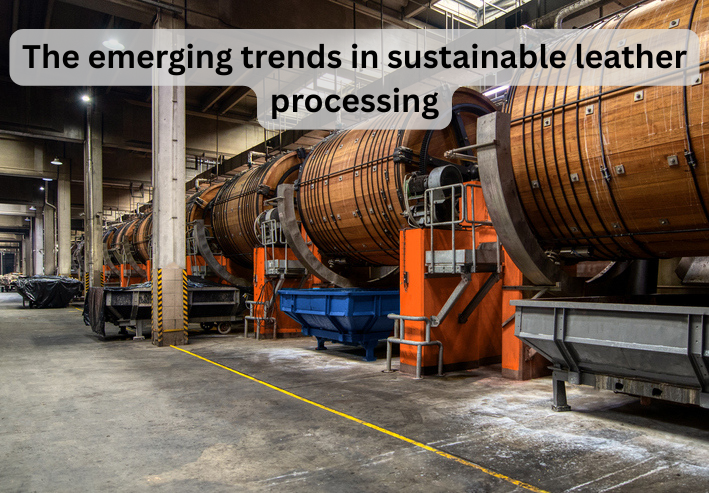Emerging trends in sustainable leather processing focus on minimizing the environmental impact of leather production while meeting modern consumer demands for ethical, eco-friendly, and high-quality products. These innovations address challenges such as water consumption, chemical usage, waste management, and carbon emissions in the traditional leather industry. Here are the key trends driving sustainability in leather processing:
1. Plant-Based and Bio-Based Tanning
Traditional leather tanning, especially chrome tanning, uses harmful chemicals that pose environmental risks. The industry is shifting toward plant-based and bio-based alternatives.
- Vegetable Tanning:
- Uses natural tannins from tree bark, leaves, fruits, and other plant sources.
- Produces eco-friendly leather with a natural finish and lower chemical impact.
- Example: Chestnut and mimosa tree extracts.
- Bio-Tanning:
- Tanning processes that use natural oils, enzymes, and microbial extracts instead of synthetic chemicals.
- Reduces water usage and eliminates toxic effluents.
- Examples include tannins from mycelium-based fungi or bacteria-derived agents.
- Hybrid Tanning Methods:
- Combining plant-based tannins with minimal chrome or other agents to improve durability while reducing chemical content.
2. Waterless and Low-Water Tanning Technologies
The leather industry traditionally consumes vast amounts of water during soaking, liming, and tanning. Innovative techniques are emerging to drastically reduce water usage.
- Waterless Chrome Tanning:
- Advanced systems eliminate water during tanning by using specialized chrome compounds or dry tanning chemicals.
- Reduces water pollution and wastewater discharge.
- Dry Tanning:
- Leather is processed using solvents or alternative chemical techniques that require minimal water.
- Results in significantly lower water consumption and waste generation.
- Water Recycling Systems:
- Closed-loop water treatment systems recycle water multiple times, reducing fresh water consumption in tanneries.
3. Use of Sustainable Chemicals
The shift to non-toxic chemicals and green alternatives is critical for reducing pollution during leather processing.
- Chrome-Free Tanning:
- Replacing chromium salts with aldehydes, plant extracts, or glutaraldehyde alternatives.
- Chrome-free leather is safer to produce and reduces health risks for workers and consumers.
- Metal-Free Tanning:
- Tanning processes that avoid metals entirely, instead using synthetic or bio-based agents.
- Ensures leather is biodegradable and eco-friendly.
- Green Chemistry Solutions:
- Use of enzymatic processes and biodegradable chemicals that have minimal impact on ecosystems.
4. Upcycling and Waste Reduction
Leather processing generates significant waste in the form of trimmings, shavings, and discarded hides. Sustainable practices focus on upcycling and reducing landfill contributions.
- Leather Offcut Upcycling:
- Scraps and offcuts are repurposed to create smaller leather goods like wallets, belts, and keychains.
- Bonded Leather:
- Leather scraps and fibers are combined with natural latex or other binders to produce reconstituted leather products.
- Reduces waste while offering an affordable, eco-friendly alternative.
- Circular Economy Practices:
- Encouraging leather manufacturers to reclaim and recycle old leather goods into new products.
5. Biofabricated and Alternative Leathers
A significant trend is the development of biofabricated leathers and vegan alternatives that mimic the properties of traditional leather.
- Mycelium Leather:
- Made from fungal mycelium (mushroom roots) that are grown and processed into durable, leather-like materials.
- Example: Mylo™ leather by Bolt Threads.
- Plant-Based Leathers:
- Derived from cactus, pineapple leaves (Piñatex), or apple peel waste. These materials are biodegradable, cruelty-free, and sustainable.
- Examples:
- Desserto® (cactus leather)
- Piñatex® (pineapple leather)
- Lab-Grown Leather:
- Uses bioengineering to grow collagen and other leather-like structures in laboratories, creating a sustainable alternative without animal slaughter.
- Recycled Leather Alternatives:
- Leather-like materials created from recycled leather fibers blended with natural binders.
6. Renewable Energy Integration
Leather processing facilities are increasingly adopting renewable energy sources to reduce carbon footprints.
- Solar Power:
- Tanneries install solar panels to power machinery and heating systems.
- Biomass Energy:
- Use of organic waste or leather offcuts to generate energy for production.
- Energy-Efficient Machinery:
- Upgraded machinery that reduces energy consumption during tanning and drying processes.
7. Transparent and Ethical Supply Chains
Consumers demand greater transparency regarding the sourcing and processing of leather. This has led to the rise of traceable supply chains.
- Traceability Systems:
- Use of blockchain technology and digital platforms to trace hides back to farms, ensuring ethical and sustainable practices.
- Ethical Sourcing:
- Partnering with farms that follow animal welfare standards and avoid deforestation.
- Certifications:
- Adoption of certifications like:
- Leather Working Group (LWG): Ensures environmental compliance in leather production.
- OEKO-TEX® Leather Standard: Certifies chemical safety in processing.
- ISO 14001: Environmental management certification.
- Adoption of certifications like:
8. Biodegradable and Compostable Leather
Innovations are making leather and leather alternatives biodegradable to ensure minimal impact at the end of their life cycle.
- Vegetable-Tanned Leather:
- Naturally decomposes over time without releasing harmful toxins.
- Natural Coatings:
- Wax or water-based finishes that are biodegradable, replacing synthetic polyurethane (PU) coatings.
9. Reduced Carbon Footprint
Leather manufacturers are implementing strategies to measure and reduce carbon emissions across production.
- Carbon-Neutral Leather:
- Offsetting emissions through reforestation, renewable energy, and carbon-credit programs.
- Life Cycle Analysis (LCA):
- Evaluating the environmental impact of leather from sourcing to disposal, identifying areas for improvement.
10. Digital and Automated Innovations
Sustainable leather processing is increasingly leveraging technology to improve efficiency and reduce waste.
- Laser Cutting:
- Reduces waste by precisely cutting leather panels with minimal offcuts.
- AI and IoT Monitoring:
- Smart systems monitor water, chemical usage, and energy consumption to optimize processes.
- 3D Printing:
- Producing smaller leather components and alternatives using less material.
Conclusion
Emerging trends in sustainable leather processing focus on reducing environmental impact, adopting eco-friendly tanning methods, innovating with bio-based materials, and increasing traceability in supply chains. From plant-based tannins to mycelium-based leathers and renewable energy integration, these practices are transforming the leather industry to meet the demands of conscious consumers while aligning with global sustainability goals.
Hashtags
#SustainableLeather #EcoFriendlyLeather #GreenLeatherProcessing #LeatherInnovation #SustainableFashion #EthicalLeather #EcoLeatherTrends #TanningTechnology #ZeroWasteLeather #CleanLeatherProduction #LeatherSustainability #FutureOfLeather #ResponsibleProcessing #LeatherIndustryTrends #CircularEconomy #EcoChicLeather #EcoConsciousLeather #EcoFriendlyFashion #EcoLeatherGoods #EcoLeatherAccessories #EcoLeatherDesign #EcoLeatherCraftsmanship







